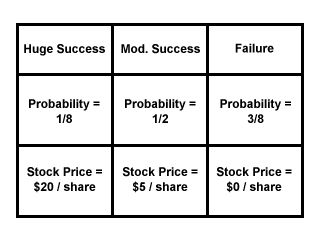Choice Based on Expected Value
In some cases, buyers must make a purchase decision without knowing exactly what they're getting for their money. Deciding whether or not to buy a good without knowing exactly what the good is worth involves some degree of risk, as there is variation in the possible outcome. To make these decisions, buyers have to evaluate, to their best ability, how much the goods are really worth, and then decide how much they are willing to pay for the goods. For example, if Jevan is interested in buying stock in a new startup, he can't be sure what will happen to the value of his stock as time passes. The company could be a huge success, making his stock very valuable, it could be a moderate success, making his stock somewhat valuable, or it could be a failure, making his stock worthless. Before he decides to buy any stock, Jevan has to decide what is the most likely outcome, and what his stock is going to be worth: that is, based on the probability of different outcomes, Jevan has to assign the stock an expected value to compare against the present price.
In order for Jevan to be able to calculate this expected value, he needs to account for all possible outcomes, so that the total probability will be equal to 1: let's assume that huge success, moderate success, and failure are the only possible outcomes, so the probability of at least one of them occurring is equal to 1. If Jevan thinks that there is a 1 in 8 chance that the startup will be a wild success, a 1 in 2 chance that it will be a moderate success, and a 3 in 8 chance that it will fail, then he has accounted for all possible outcomes, since the combined probabilities are equal to 1: (0.125 + 0.5 + 0.375) = 1
Next Jevan has to assign values to each outcome. In the event of huge success,
Jevan thinks that each share of stock will be worth $20. In the event of
moderate success, each share will be worth $5. In the event of failure, each
share is worth $0. Combining all of Jevan's assumptions gives us the following
chart of his expectations:

Jevan's Expectations for the Startup Stock's Performance
EV = (0.125)(20) + (0.5)(5) + (0.375)(0)
EV = $5 a share
We find that Jevan expects the stock to be worth about $5, based on his
assumptions about company performance. What this means is that Jevan will not
be willing to pay more than $5 a share for this stock, since he believes it to
be worth $5 a share. He will probably be willing to buy stock if the price is
lower than $5, depending on how much he enjoys taking risks.
How would we explain it if the price is lower than $5, but Jevan decides not to buy any stock? We know that he believes the stock to be worth $5, so we would expect him to buy stock if it is priced lower than $5 a share. This can be explained by Jevan's openness to taking risks. Because the future price of the stock is uncertain, and Jevan's estimate is only an estimate, if Jevan doesn't like taking risks, that is, if he is risk-averse, then he may choose not to buy any stock, even if the expected returns are positive; he is not willing to invest in a "good" investment because he is still afraid of the possibility that he might lose money. Someone who is risk-averse will choose investments with little variation in possible outcomes, and a high degree of predictability.
On the other hand, if the price of the stock is over $5, and Jevan still decides he wants to buy stock, even though he believes it to be worth only $5 a share, then it may mean that he is risk-loving; he is willing to enter into an expected loss on the off chance that the company will make it big. This would be an extreme case; not all risk lovers will invest in stocks with negative expected values. More commonly, risk lovers will make investments that have positive expected values, but have very large variation in possible outcomes.
If Jevan is risk-neutral, then he will not buy stock with negative expected value, he will buy stock with positive expected value, and stock with 0 expected value makes no difference to him at all. Even if the risk is very high, if the expected returns are positive, he will make the purchase. Even if the risk is very low, if the expected returns are negative, he will refuse to buy stock.


 payment page
payment page



